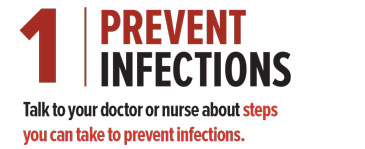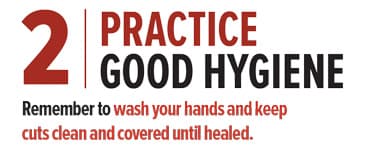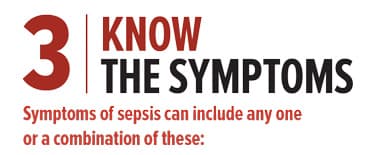Sepsis: The Silent Assassin in the Shadows
 I'll
never forget an article I read that snapped me out of a lazy Sunday afternoon. Dana Mirman had been rushed to the hospital. Why? Sepsis. No, she didn't know what it was either. But let me tell you, sepsis is a name you should get to know, just
like you know the words "flu" or "migraine." Read Dana’s complete story here.
I'll
never forget an article I read that snapped me out of a lazy Sunday afternoon. Dana Mirman had been rushed to the hospital. Why? Sepsis. No, she didn't know what it was either. But let me tell you, sepsis is a name you should get to know, just
like you know the words "flu" or "migraine." Read Dana’s complete story here.
What Actually is Sepsis?
The Sordid History of Sepsis

Prevent Infections: The First Line of Defense

Practice Good Hygiene: Your Personal Shield Against Sepsis
Think of good hygiene as your day-to-day armor in the battle against the microscopic invaders that can lead to sepsis. Washing your hands regularly isn't just a good habit; it's like having a bouncer at the door of Club You, turning away unwanted bacteria and viruses. When it comes to cuts, scrapes, or any break in the skin, keeping them clean and covered is like sealing your castle's secret entrance against a Trojan horse full of germs. Simply put, maintaining impeccable hygiene is your personal 24/7 security detail against infections that can spiral into sepsis. So, keep those hands washed and wounds protected; it's a small effort that yields a massive health dividend.

Know The Symptoms: Your Early Warning System for Sepsis
Knowing the symptoms of sepsis is akin to having a smoke detector that can sense a fire before you even smell the smoke. Confusion, shortness of breath, rapid heartbeat, fever, chills, extreme discomfort, clammy skin—these aren't just unpleasant experiences; they're flashing red lights on your body's dashboard screaming, "Something is really wrong!" Recognizing any combination of these symptoms early on can be the golden ticket to catching sepsis before it evolves into a life-threatening monster. If you’re equipped with this knowledge, you can seek medical help immediately, giving healthcare providers a head start in stopping sepsis in its tracks. So, think of knowing the symptoms as your life-saving cheat sheet in the high-stakes test of your well-being. Ask your healthcare provider, "Could this infection be leading to sepsis?"

Act Fast: The 'Now or Never' Moment in Sepsis Management
In the unfolding drama of a sepsis episode, speed isn't just a virtue—it's a necessity. Think of sepsis as a ticking time bomb: The quicker you defuse it, the less damage it does. If you or someone you know shows signs of sepsis, or if an existing infection isn’t improving—or, heaven forbid, is getting worse—getting medical care immediately is the equivalent of calling the bomb squad. Every minute counts, and procrastination is your enemy here. Immediate medical intervention increases your odds of turning what could be a tragic tale into a survivor's story. So when it comes to sepsis, treat time like gold and act swiftly; it could make all the difference between recovery and irreversible damage.
The Risks and Rewards of Playing "Google Doctor" with Sepsis
Knowing the signs and acting fast can literally be a lifesaver. But here's the catch-22: Misinterpreting your symptoms can lead to unnecessary panic. You're not always dying when you Google your symptoms, right? But if you're at risk—older adults, recent hospitalization, weakened immune systems—erring on the side of caution and heading to our Urgent Care or the Emergency Department is a smart bet.
Who Is At Risk of Sepsis?


The Risks and Rewards of Playing "Google Doctor" with Sepsis
Let’s Bring It Home: Our Hospital and Our Community
Sepsis is a big deal, people. It’s a real party crasher, an unwelcome visitor, a true villain in the healthcare world. So, be vigilant. Know the signs. Act fast.
Let's take sepsis awareness from a whisper to a shout, shall we?
